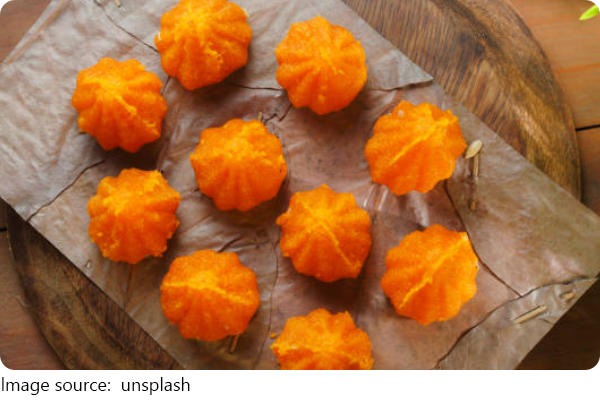Modak Recipe

Modaks are believed to be the favorite sweet of Ganpati Bappa. These delightful dumplings are traditionally offered to Lord Ganesha during festivals like Ganesh Chaturthi and Sankashti.
Originating from Maharashtra, India, the recipe for Modaks has been cherished for generations and continues to be a symbol of joy, prosperity, and devotion.
What are Modaks?
Symbol of Happiness and Prosperity
Modaks are traditional Indian sweets prepared as offerings during the ten-day Ganesh Chaturthi festival. The word "Modak" is derived from the Sanskrit word "Moda," meaning happiness and joy. The unique shape of Modaks is said to resemble bags of money, symbolizing the wealth and prosperity Lord Ganesha bestows on his devotees.
Kaddu Ki Kheer Recipe | Pumpkin Payasam Recipe You Shouldn't Miss!
Anjeer Halwa: A Nutritious & Indulgent Dessert To Amaze You!
Holiday feasts everywhere? Stay fit and enjoy the treats with these expert nutrition tips—no extra pounds needed!
Unbelievable! Star anise water’s powerful benefits—from digestion to immunity, these 5 perks will amaze you!
Want to fight heart disease and dementia? Eating just five mushrooms daily could make all the difference!
Shocking! Is apple cider vinegar the ultimate beauty secret? Get ready for your skin to glow like never before!
Varieties of Modaks
Traditionally, there are two types of Modaks: fried and steamed. Over time, innovative varieties like mawa modak, chocolate modak, and coconut modak have emerged, each offering a modern twist to this classic sweet.

What are Ukadiche Modaks?
Steamed Delicacy
Ukadiche translates to "steamed" in Marathi, making these Modaks a healthier choice among Indian sweets. They are a special offering made on the first day of Ganesh Chaturthi, believed to be Lord Ganesha’s favorite. These soft rice flour dumplings are filled with a delectable coconut and jaggery mixture, making them irresistible.
Maharashtrian Origin
Ukadiche Modak is a beloved Maharashtrian recipe passed down through generations. The sweet filling combines ghee, shredded coconut, jaggery, nutmeg, and cardamom powder, creating a melt-in-the-mouth experience. The dough is carefully shaped into Modaks using either molds or skilled hands.
What is Modak Filling Made Of?
Ingredients for the Filling (Saran)
The filling, known as "saran" in Marathi, is a rich combination of:
Ghee: Homemade or store-bought, it adds a rich flavor.
Coconut: Freshly shredded coconut is ideal, but thawed frozen coconut also works well.
Jaggery: Kolhapuri jaggery is recommended for its perfect sweetness and color.
Spices: Cardamom powder and nutmeg powder lend a warm, aromatic touch.
Tips for Perfect Filling
For the best results, use fresh or thawed frozen coconut. Ensure the jaggery melts evenly by cutting it into small pieces. Avoid powdered jaggery, as it melts too quickly and may burn.
easy ukadiche modak - 2 ways | ganesh chaturthi modak banane ki vidhi | गणेश चतुर्थी मोदक रेसिपी
Video by Hebbars Kitchen
What is Ukad?
The Dumpling Dough
Dear Lykkers! Ukad is the rice flour dough used to make the outer layer of Modaks. It is prepared by boiling a mixture of milk and water, adding ghee and salt, and then gradually stirring in rice flour. The dough is kneaded while warm to achieve a smooth and pliable texture.
Key Ingredients for Ukad
Rice Flour: Use finely ground, fresh rice flour for the best results.
Milk: Optional but adds softness to the dough.
Ghee: Adds richness and makes the dough easier to handle.
Salt: Enhances flavor.
Step-by-Step Recipe for Ukadiche Modak
Preparing the Saran (Filling)
Heat 2 tablespoons of ghee in a frying pan and temper with seeds.
Add 2 cups of shredded coconut and jaggery.
Stir until the jaggery melts and the mixture thickens.
Add cardamom powder and nutmeg powder. Mix well and let it cool.
Making the Ukad (Dough)
Boil 1.5 cups of water and 0.5 cups of milk.
Stir in 1.5 cups of rice flour until a dough forms.
Steam the dough for 10 minutes and then knead it with ghee and warm water for smoothness.
Shaping the Modaks
With Molds: Grease the mold, press the dough inside, fill with the saran, and seal.
Without Molds: Flatten a dough ball, create pleats, add filling, and seal manually.
Steaming the Modaks
Place Modaks in a greased steamer tray.
Steam for 15 minutes on medium-low heat.
Drizzle with ghee and serve warm.
Serving and Storage
Serving Suggestions
Serve warm Ukadiche Modaks with a drizzle of ghee. Pair them with a festive Maharashtrian meal including puris, batata bhaji, and masale bhaat.
Storage Tips
Store in an airtight container in the refrigerator for 2–3 days. Reheat by steaming for 3–4 minutes or microwaving with a damp paper towel for 45 seconds.

 · Food Team
· Food Team